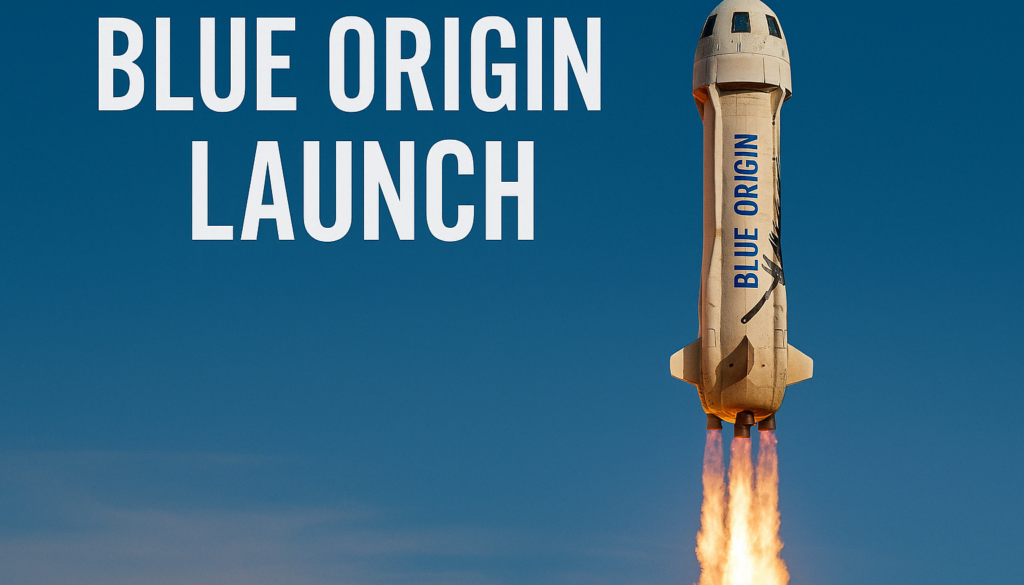Blue Origin Launch: A Bold Leap Toward the Future of Space Travel
Blue Origin Launch – Ushering in a New Era of Commercial Space Travel
Introduction to Blue Origin
The Blue Origin launch has taken center stage in today’s space race, redefining what’s possible in commercial space exploration. Founded by Amazon’s Jeff Bezos, Blue Origin is on a mission to make space travel accessible, sustainable, and safe — and the latest launch reaffirms its growing role in this revolution.
What Happened During the Latest Blue Origin Launch?
The recent Blue Origin launch featured the New Shepard suborbital vehicle — a fully reusable spacecraft designed for short trips to space. It took off from the company’s private launch site in West Texas and returned successfully, showcasing advancements in reusable rocket technology.
Mission Overview:
- Launch Vehicle: New Shepard
- Launch Site: Launch Site One, West Texas
- Flight Type: Suborbital
- Payload: Research experiments & space tourists
- Flight Duration: Approx. 11 minutes
This successful flight is not just another achievement — it’s a bold step toward frequent, safe, and cost-effective commercial space travel.
Technology Behind the Blue Origin Launch
- The New Shepard system is built for autonomy, safety, and reusability. Its key components include:
- Reusable Booster with vertical takeoff and landing
- Pressurized Crew Capsule featuring the largest windows flown in space
- Escape System for passenger safety
- Precision Thrust Control for soft landings
This launch vehicle’s reuse lowers costs significantly and positions Blue Origin as a sustainable player in the space industry.
Behind the Scenes – Who Builds Blue Origin’s Rockets?
The Blue Origin launch success is driven by some of the brightest minds in aerospace engineering. Headquartered in Kent, Washington, the company boasts a team of over 3,500 employees including former NASA engineers, physicists, software developers, and propulsion experts.
One of the standout engineering feats is the BE-3 engine, a liquid hydrogen/liquid oxygen-powered engine that powers New Shepard. For future missions, Blue Origin is developing the BE-4, which will also be used by the United Launch Alliance in their Vulcan Centaur rocket.
These innovations are built entirely in-house, showcasing the company’s commitment to self-reliance and technological leadership in private spaceflight.
Why This Blue Origin Launch Matters
The importance of this launch lies in three pillars:
- Commercialization of Space: This launch further opens the door to private citizens experiencing space firsthand.
- Scientific Advancement: The payload included university and NASA-backed experiments studying microgravity.
- Environmental Sustainability: The vehicle’s reusability reduces space waste and cost per launch.
Fun Fact: Blue Origin’s motto “Gradatim Ferociter” means “Step by Step, Ferociously” — a testament to its focused, deliberate progress.
Why choose Blue Origin?
- Reaches the Kármán Line (official edge of space)
- Fast turnaround between flights
- Fully automated capsule (no pilot required)
- Vertical launch mimics traditional astronaut experiences
FAQ’S
What is Blue Origin’s goal?
Blue Origin aims to build a future where millions of people live and work in space by developing affordable and sustainable spaceflight systems.
How safe is Blue Origin for space tourists?
Extremely safe. New Shepard includes an automated escape system, multiple redundancies, and thorough safety protocols.
How much does a Blue Origin ticket cost?
While exact pricing varies, early tickets have ranged between $200,000 to $500,000. Prices may drop with increased frequency.
Environmental Considerations of Blue Origin’s Rockets
Unlike many traditional rocket systems, Blue Origin’s New Shepard is environmentally considerate:
- Clean fuels: Uses liquid hydrogen and oxygen — resulting in only water vapor emissions
- Reusability: Reduces waste by reusing both capsule and booster
- Quiet launches: Compared to older rockets, New Shepard is less disruptive to nearby ecosystems
This aligns with Jeff Bezos’s broader vision of moving heavy industry off Earth to protect our planet’s natural resources.
Key Milestones from the Blue Origin Launch Program
- First Flight: 2015
- First Human Flight: July 20, 2021 (with Jeff Bezos onboard)
- Number of Launches: 20+ and growing
- Recovery Success Rate: Over 90% for New Shepard
Blue Origin continues to set records while proving that private spaceflight is no longer science fiction.
The Bigger Picture – Space for Everyone
Blue Origin envisions a future where space is not just for astronauts, but for researchers, entrepreneurs, and everyday people. This vision fuels innovation in areas like:
- Orbital Habitats
- Lunar Missions (via Blue Moon lander)
- STEM Education Programs
- Public-Private Partnerships with NASA
Every Blue Origin launch is a reminder that we are edging closer to a spacefaring civilization.
Final Thoughts – The Future of Blue Origin Launches
The Blue Origin launch is more than just a spectacle — it’s a signal of how fast we’re moving toward democratizing access to space. With reusable rockets, commercial opportunities, and scientific payloads, Blue Origin is well on its way to fulfilling its grand vision.
Call-to-Action
💬 Inspired by this Blue Origin launch?
Leave a comment below and tell us what excites you most about the future of space travel!
📥 Don’t forget to subscribe to Chill Chirp for more space insights, tech updates, and future launch alerts.



